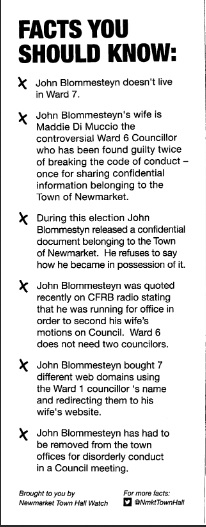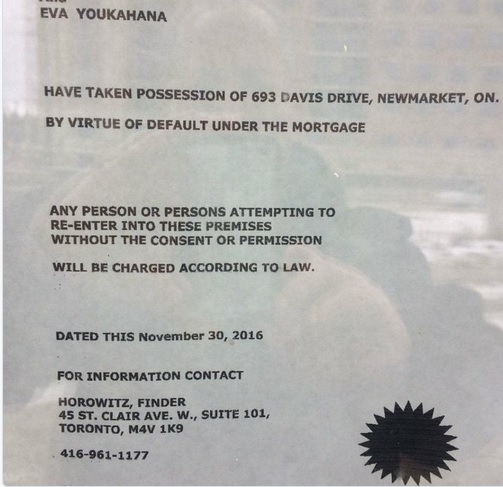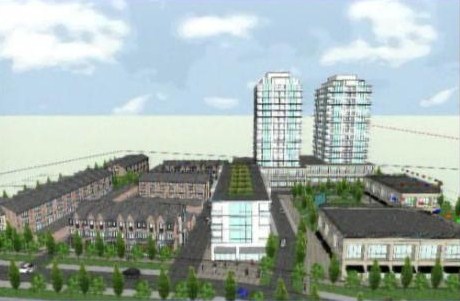- Details
- Written by Gordon Prentice
Read this first: Maddie Di Muccio refers to the anonymous blog NmktTownHall. This Nwmarket Town Hall Watch was a spoof and existed for a short period in 2014 in the run up to the October Municipal election. It had no connection with the similarly anonymous NwktTownHall which is alive and well and still publishing. (Nmkt = spoof. Nwkt = real)
Drama Queen
The tortured drama queen and wannabe PC MPP for Newmarket-Aurora, Maddie Di Muccio, is at it again. 
She claims the woman who was elected in her place as councillor for Newmarket's Ward 6 – Kelly Broome - only succeeded because of
"her despicable tactics".
Di Muccio says Broome's employer, Snap'd newspaper, was responsible for sending out "vile and disgusting smears" about her and her family in the run up to the Newmarket municipal election in October 2014.
So what does Di Muccio specifically allege?
She says that on 17 October 2014 Snap'd Newspaper Group was responsible for circulating via Canada Post 9,291 flyers from "Newmarket Town Hall Watch" which Di Muccio describes as "hate mail" which "smeared my family's reputation".
She says
(1) Kelly Broome is employed/contracted with Snap'd
(2) Snap'd Chief Executive, Paul Dutton, sent out "defamatory" flyers
(3) Dutton made a generous cash contribution to Kelly Broome's campaign for Ward 6 (the Ward Maddie Di Muccio represented at the time).
(4) A Snap'd owner, Steve Hinder, "helped chair her campaign".
Di Muccio alleges Kelly Broome "cheated, manipulated and lied her way into political office" without specifically itemising what Broome is alleged to have done.
Di Muccio must set out the facts that she relies on - not assertions or speculations. It is not enough to spray around allegations of wrongdoing. People who are named by her must know precisely what she is accusing them of.
Paul Dutton: the name in the frame
She says Snap'd Chief Executive Paul Dutton
- contributed to several political campaigns
- used Snap'd as an organiser for the PC Party of Ontario.
These are lawful activities.
Corruption
But, importantly, Di Muccio claims politicians close to Snap'd
"benefitted from generous donations of Snap'd Newspaper Group and their CEO Paul Dutton"
and that
"Snap'd benefitted too because so much of their ad revenue now comes from those same shady politicians who won their seats in 2014".
The inference is they (the politicians) are corrupt. If she believes this, she must name names and explain the corrupt actions in detail. It is not enough to smear or suggest guilt by association. 
Di Muccio goes on to assert:
"considering the copious donations Snap'd Newspaper Group/ Paul Dutton doled out to winning Newmarket council candidates, such as their employee Kelly Broome, one speculates if Municipal Act rules were violated, since there are limits on spending".
Here she is, speculating again. Di Muccio says
"we believe Snap'd Newspaper Group may have violated election spending rules, we will be investigating it further".
Election expenses validated by audit
Kelly Broome's Financial Statement detailing her expenses for the October 2014 election was professionally audited. The spending limit issued by the Town Clerk was $12,661.05. Broome spent $12,043.25.
So far as the Snap'd connection is concerned, Broome received a donation of $500 from its Chief Executive, Paul Dutton. She also benefitted from a half page ad in Snap'd with a declared value of $725.46
This story, in various forms, has been around for a long time. The real Nwkt Town Hall Watch tweeted in October 2014
Nwkt Town Hall Watch
@NwktTownHall
.@maddiedimuccio my sources have linked @nmkttownhall to @tonyvanbynen and various local Masons. Will have concrete evidence to reveal soon.
2014-10-25, 4:17PM
I, for one, am still waiting for concrete evidence that the Municipal Act has been broken.
And if Snap'd did circulate a flyer, as alleged, Paul Dutton will, no doubt, wish to explain why.
This email address is being protected from spambots. You need JavaScript enabled to view it.
Note: Di Muccio talks of the flyer containing vile and disgusting smears. Seems pretty standard stuff to me given the nature of local politics at the time. Here (above right) is the related flyer that circulated in Ward 7 where Di Muccio's husband, John Blommesteyn, was seeking election.
- Details
- Written by Gordon Prentice
As expected the successful candidate in last October's Ward 5 by-election, Bob Kwapis, had the biggest war chest and outspent most of his rivals by far. He was the only candidate required to produce an auditor's report as his total expenses were over $10,000.
Campaign expenses were capped by the Town at $11,636.10 and candidates were required to return their completed campaign financial statements to the Town Hall by 2 pm on January 3, 2017.
The Town's website shows that Tracee Chambers has not filed her statement yet. I am sure there is some innocent explanation that will soon be forthcoming.
The Council by-election in Ward 5 last October was important in many ways.
We had a terrific field of eight candidates. There was someone for everyone. And the campaign itself was spirited with most of the candidates rejecting the proposed Clock Tower development in the heart of the Ward. Only Ian Johnston and Tom Pearson thought there was some merit in Forrest's plans and both got trounced.
That said, we owe all the candidates a big round of applause for taking the trouble to stand for election - often at considerable personal cost. I see Darryl Wolk's campaign was largely funded by the candidate himself who contributed $7,085. Ron Eibel contributed $2,000 to his campaign. Kwapis (shown right) contributed an eye-watering $13,168 to his own campaign although an unspent $6,168 was refunded to him. 
Ian Johnston, eccentrically, spent absolutely nothing on his campaign and clearly did not expect to be elected. His return tells us he
"did not accept any contribution or incur any expenses other than the nomination fee".
But the big story must be Bob Kwapis who carpet-bombed his opponents financially, spending $3,079 on advertising and $2,680 on brochures. He spent $4,429 on his blitzkrieg of election signs which covered the face of the entire Ward. He also spent $10 on an electronic voter list which was probably worth its weight in gold.
The money Kwapis could theoretically draw on, his "total campaign income" at $18,728, dwarfed the runner up, Darryl Wolk, who declared $9,835. (The campaign expenses are, of course, capped at the same level for all candidates. So you can have all the money in the world but it is of no use if you can't spend it.)
So, what do I take from all this?
You can't get elected if you spend nothing or next to nothing.
And if you are serious about getting elected - and spend a small fortune - you still need a story to tell that will resonate with the voters.
Voting systems matter in determining outcomes. (see note below)
This email address is being protected from spambots. You need JavaScript enabled to view it.
Note: In deciding who wins elections we cannot ignore the impact of the voting system. First-past-the-post may be on its way out in some municipalities.
In Newmarket, a special Committee of the Whole at 9am on 30 January 2017 "will address internet voting and ranked ballots". (See Committee of the Whole agenda for 16 January2016 - Outstanding Matters, item 2.)
- Details
- Written by Gordon Prentice
The Town confirmed on Monday 9 January that it had received notice of an appeal to the OMB by the developer Bob Forrest following its widely applauded decision to reject the proposed redevelopment of the Clock Tower lands in the heart of the heritage conservation district.
I am told the Town is currently processing the appeal
"and will be submitting it to the OMB later this month".
The developer's deadline for triggering an appeal was Thursday 5 January.
The Town says it has 15 days in which to forward the notice of appeal and its response which would take us to the end of next week.
I suspect Forrest's appeal will pick up on the points raised is his intemperate letter to the Mayor and Councillors of 28 November 2016. (Scroll to last item in page 2 and open.) He will no doubt bang on about delays in processing the application. The points he is likely to make can all be easily dealt with.
For its part, the Town says with simplicity and admirable clarity that the application was rejected on 5 December 2016 because:
"the development of the subject lands as proposed would adversely impact the character of the established neighbourhood and adjacent properties within the Heritage Conservation District".
I expect the Staff's proposed response to Forrest's OMB appeal will be formally approved by councillors - and amended if necessary.
In any event, we know the Town's opposition to Forrest's plans is not going to change. Tony Van Trappist admitted as much when he told the Committee of the Whole meeting on 28 November 2016 (after it had rejected the Forrest application) that
"we will be guided by the decision of the majority of this Council."
Van Trappist was, of course, the only member of Council to support the staff's amended version of Forrest's application. The decision to reject the original Forrest application was unanimous.
Forrest's letter, setting out the detailed reasons for his appeal to the OMB, and the Town's response, will be essential reading for anyone seeking Party or Participant status at the OMB Hearing.
All this material should be posted on the Town's website at the same time it is sent down to the OMB in Toronto.
Even if Forrest were to win the OMB Appeal (the chances of which are vanishingly remote) what would he have achieved?
He still won't be able to develop the Clock Tower as proposed because he needs Town owed land which will never in a thousand years be forthcoming.
For me, this is the enduring mystery.
This email address is being protected from spambots. You need JavaScript enabled to view it.
- Details
- Written by Gordon Prentice
My spies tell me the trial date has now been set for 10 February 2017 at the Small Claims Court in Newmarket.
At long last the end of this ludicrous psycho drama is in sight.
Di Muccio's allegations of abuse of power, targeted malice and intentional infliction of mental suffering are totally absurd and risible. And then there are the claims of injurious falsehoods and breach of confidence and breach of privacy.
It has always been my view that the Courts should never be used to settle old political scores. 
When she is not litigating, former Newmarket councillor, Matilde Di Muccio, is hard at work seeking the PC nomination for Newmarket-Aurora for the next Provincial election in 2018. The last time she went for the nomination she was blocked by the then PC leader, Tim Hudak, who believed she was sub-standard material.
It beats me why she, a PC parliamentary hopeful, still includes on her website an ancient testimonial from Liberal Leader Kathleen Wynne:
"Maddie is an intelligent, passionate and able woman who will be a great addition to Newmarket's Town Hall. Her community experience, her leadership skills and her drive to bring positive change to those around her will make her a strong Town councillor. Her no-nonsense approach to problems will make her a leader."
These days, Di Muccio doesn't think much of Kathleen Wynne who said such nice things about her in the past - before she (Di Muccio) was elected.
Di Muccio sneaked on to Newmarket Council in 2010 with a majority of 37, taking 27.5% of the vote. After four years, the electors in Ward 6 had had enough and kicked her out, her share of the vote dropping to 24.6%.
Anyway... Maddie now insists:
"After 13 years of Dalton McGuinty and Kathleen Wynne it's time for a new direction..."
If Maddie floods the riding association with new paper members and, against all the odds, gets the nomination everything will go south.
That will be the new direction.
This email address is being protected from spambots. You need JavaScript enabled to view it.
- Details
- Written by Gordon Prentice
Plans to redevelop the Hollingsworth Arena site have disappeared in a puff of smoke. 
FivefortheDrive today tweets that the swashbuckling developer, Sandro Sementilli, has defaulted on his mortgage on 693 Davis Drive, posting an image of the repossession notice at the property.
The developer's San Michael Homes website has vanished into thin air.
A report to Newmarket's Committee of the Whole on 18 October 2016 on Hollingsworth was unexpectedly pulled from the agenda. (See item 4)
The Town's Chief Administrative Officer, Bob Shelton, told councillors there had been changes to the agenda:
“Item 4 regarding San Michael Homes and (the) Hollingsworth property has been withdrawn and will come forward along with the signed letter of intent when that is ready. It should come together.”
Given what we now know, a signed letter of intent isn't going to be coming any time soon.
I blogged about the Hollingsworth saga over a year ago. The presentation and the artwork from the developer's architect Harry Kohn clearly showed two towers. 
But when Mr Sementilli made his unforgettable partnership pitch to councillors on 20 October 2015 he only ever mentioned one tower.
I remarked at the time that, curiously, no-one picked him up on this.
Newmarket's Mayor Tony Van Bynen told the ERA newspaper that
“Yes, this project is not without risk … but we would be doing our residents a disservice if we did not explore these opportunities to the fullest.”
Perhaps we shall all be told in due course how and why it all went pear-shaped.
It would be nice to know.
This email address is being protected from spambots. You need JavaScript enabled to view it.
Page 185 of 287